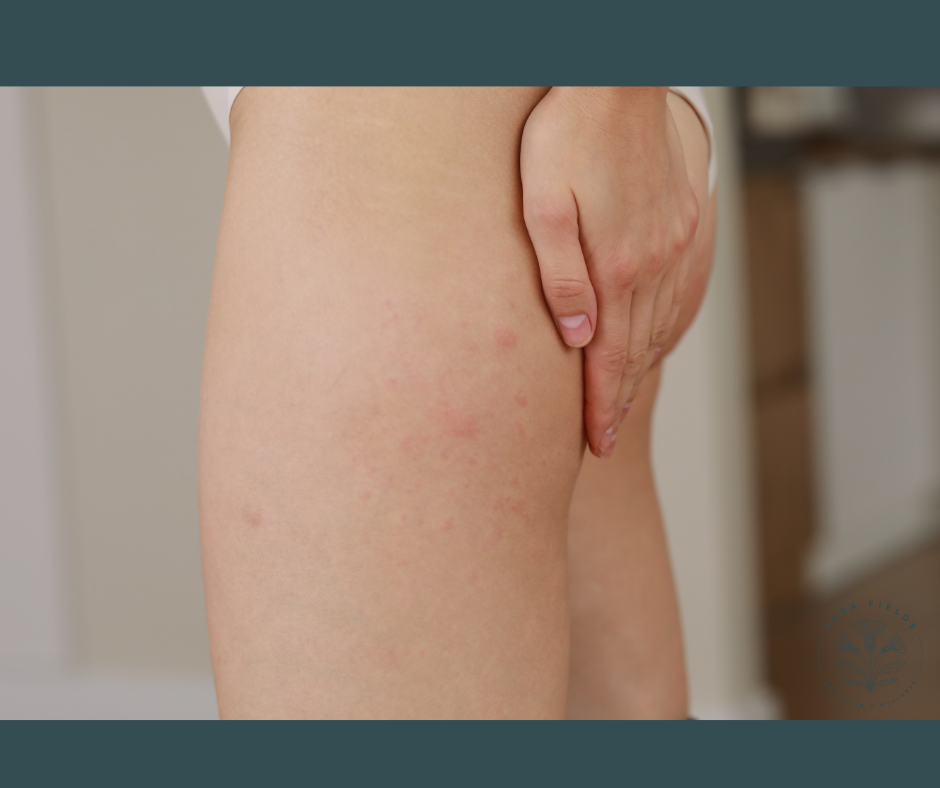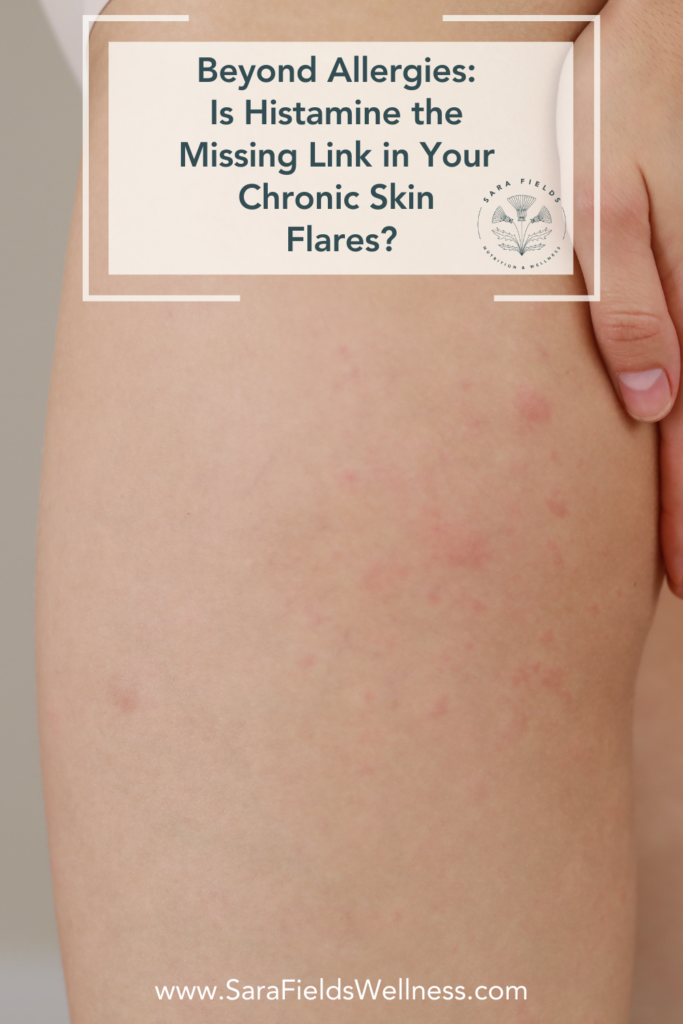
You’ve cut dairy. Switched out skincare. Tried every “anti-inflammatory” diet TikTok could throw at you. You’ve been on topical steroid creams or other medications.
And yet… the skin flares keep coming.
Redness. Bumps. Itching. Burning. Cystic breakouts.
If your skin seems to react to everything—or nothing—you’re not alone. And no, you’re not being dramatic. There might be a reason none of your go-to strategies are working:
Histamine.
We tend to associate histamine with seasonal allergies, but for many people, histamine overload—or poor histamine breakdown—can trigger systemic inflammation that shows up on your skin.
In this post, we’ll unpack:
- Why histamine isn’t just an allergy thing
- The surprising ways it can affect your skin (yes, even acne and rosacea)
- What causes histamine to build up
- What you can do to feel better—starting today
What Is Histamine, Really?
We tend to think of histamine as something we take antihistamines for, but your body actually makes histamine on purpose. It’s a chemical messenger that plays a role in digestion, immune defense, sleep regulation, and allergic responses.
But here’s the catch: you need the right amount at the right time.
When histamine builds up in your body faster than you can break it down, you can develop what’s called histamine intolerance—or what I sometimes call a histamine imbalance.
And when that happens? It doesn’t just affect your nose. It can wreak havoc all over your body—including your skin.
So, while histamine is super important for increasing blood flow and managing inflammation, it’s not so great when your face turns tomato-red every time you have a glass of wine or eat leftover chicken.
Top Skin Issues Linked to Histamine
Histamine-related symptoms can show up in multiple ways on the skin, and these are the most common:
Eczema (Atopic Dermatitis)
- Intense itching, rashy patches, dry or cracked skin
- Can be triggered by high-histamine or histamine-liberating foods, environmental allergens, or stress
Hives (Urticaria)
- Raised, red, itchy welts—often short-lived but recurring
- A hallmark sign of histamine reactivity
Rosacea
- Flushing, burning, visible capillaries, and inflammatory bumps
- Sometimes worsened by wine, heat, spicy foods—all histamine triggers
Acne (Especially Cystic or Inflammatory Types)
- Histamine increases skin inflammation and immune activation
- Can worsen breakouts or make skin more reactive
- Often flares with PMS (estrogen reduces histamine breakdown)
Itchy, Reactive Skin
- Burning, itching, tingling, or stinging sensations
- Often related to histamine’s effects on nerve endings in the skin
What Causes High Histamine Levels?
Some people have an excess of histamine in their system. Others don’t break it down well. Most people with chronic symptoms are dealing with both.
Here’s what I look for in my practice:
1. Gut Dysfunction
- Your gut produces histamine and DAO—the enzyme that breaks histamine down.
- If you have dysbiosis, leaky gut, or bacterial infections, your histamine levels may increase.
- Certain bacteria can even produce histamine directly.
2. Hormonal Imbalance
- Estrogen increases histamine and slows down DAO activity, so histamine issues often flare during PMS or in estrogen-dominant states.
3. Poor Liver Detox
- Your liver is responsible for breaking down histamine through methylation. If your detox pathways are sluggish, histamine can build up.
4. Environmental Triggers
- Mold exposure is a big one—it can upregulate histamine release.
- Pollens, chemicals, and even stress can prime your immune system for a histamine response.
5. High-Histamine Diet
- Histamine is naturally present in many foods, especially aged cheese, cured meats, fermented foods, leftovers, alcohol, tomatoes, spinach, and avocados.
- Some foods also trigger histamine release or block DAO, even if they aren’t high in histamine themselves.
Symptoms That Might Point to Histamine Intolerance
Histamine issues rarely show up in just one way. If you’ve checked multiple boxes below, it’s worth investigating:
- Skin flares (eczema, hives, acne, rosacea)
- Headaches or migraines
- Flushing or redness after meals or wine
- Nasal congestion, postnasal drip
- Digestive issues (bloating, diarrhea, reflux)
- Anxiety, insomnia, or irritability
- Worsening symptoms before your period
- Sensitivity to multiple foods, especially leftovers or fermented items
What You Can Do to Lower Histamine Naturally
1. Start with Food
You don’t have to go on a forever low-histamine diet, but for many, it can be a very effective short-term solution to help reduce the “histamine bucket overflow.”
- Try cutting back on leftovers, fermented foods (sauerkraut, kombucha), wine and alcohol, aged cheeses and cured meats, spinach, avocados, and tomatoes.
- Focus on fresh-cooked meals, leafy greens, root veggies, and clean proteins.
2. Support DAO + Histamine Breakdown
Some supplements that can help:
- DAO enzyme (especially before high-histamine meals)
- Vitamin C – a natural antihistamine
- Quercetin – a flavonoid that stabilizes mast cells
- B6 + B12 + folate (methylated forms) – support methylation and histamine clearance
3. Improve Gut and Liver Function
This might mean:
- Taking digestive enzymes or bitters to support food breakdown
- Healing the gut lining with IgG, zinc carnosine, or L-glutamine
- Using targeted probiotics (but not all are helpful—some strains increase histamine)
- Supporting liver pathways with milk thistle, NAC, or glutathione
4. Reduce Environmental Triggers
If you suspect mold, don’t ignore it. It’s one of the biggest histamine triggers I see—especially for severe, chronic skin issues like eczema.
Also consider:
- Swapping fragranced personal and home products
- Using a HEPA air filter
- Vacuuming regularly
When to Consider a Deeper Dive
If your symptoms are chronic and you feel like you’ve tried everything, testing can provide clarity.
These are my go-to tools when working with clients:
- Stool test (like the GI-MAP): reveals histamine-producing bacteria, leaky gut, and detox markers
- Food sensitivity testing (like MRT): identifies foods that are triggering and inflammatory response
- Mold and environmental toxin testing: uncovers big immune disruptors
- Hormone testing: especially for cyclical skin flares
Final Thoughts
You’re not imagining it—and your skin isn’t betraying you.
If you’ve tried “all the right things” and still feel inflamed, itchy, red, or broken out, histamine might be part of the puzzle.
The good news? Once we understand why histamine is building up in your body, we can take real steps to rebalance from the inside out.
Are you curious if you could be suffering from histamine? Try our free Histamine Reaction Checklist to see where you rank.

leave a comment